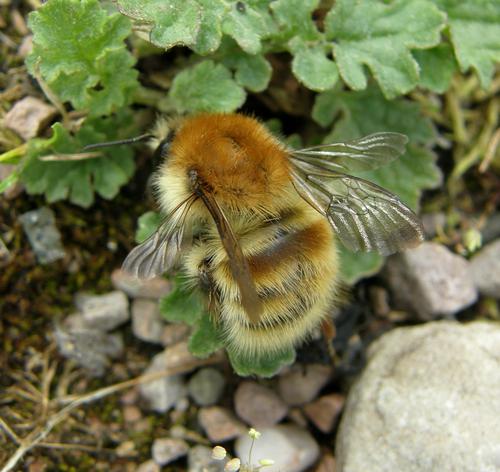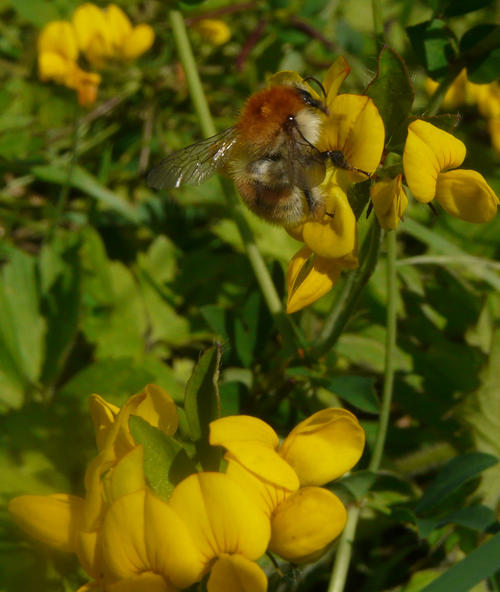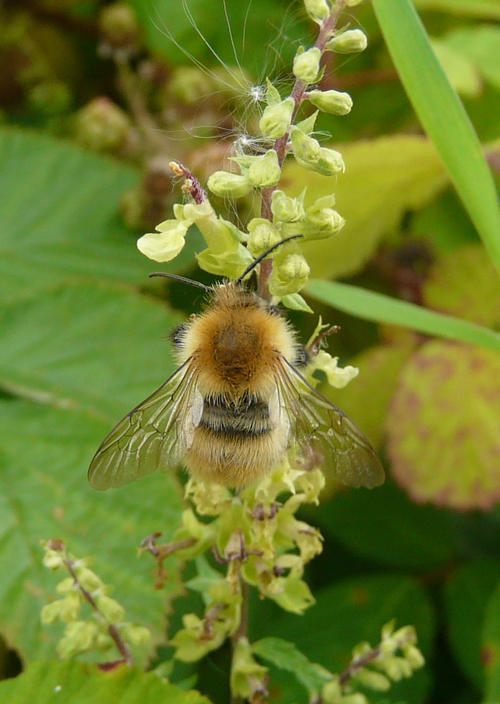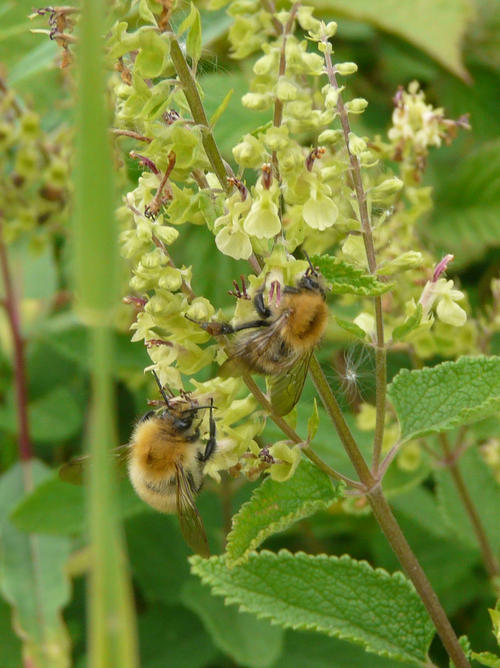Bombus humilis, the Brown-banded Carder Bee, in Worcestershire
Brett Westwood
When entomologist Steven Falk visited Hartlebury Common in June this year, little did he know of the reverberations his findings would make in the world of Worcestershire bumblebee recording. Among the bees he found around the Wilden Top car-park at the north side of the common were “a few queens of Bombus humilis”, dropped casually into a longer list. For those of us who had been grappling with bumblebee identification, and therefore paying close attention to the county’s species, this news was nothing short of seismic.
To begin with, we didn’t know it was in Worcestershire, least of all at a location which has been regularly scoured by hymenopterists over the years. Bombus humilis, the brown-banded carder bee, is also a rare Biodiversity Action Plan (BAP) species, on the decline almost everywhere and so was hardly expected to re-appear. More worryingly it was an object lesson in knowing your patch too well and seeing only what you expect to see. We didn’t think it was there so it couldn’t be. Except of course that it was. Humiliating, you might say.
On June 23rd, a few days after Steven Falk’s record, I visited Hartlebury Common on a very hot evening. A short search produced a single queen B.humilis, flying fast and low over sandy, tussocky ground, clearly looking for a nest site, and on the third evening visit there were two queens. It was a good start.
Status and distribution
The Brown-banded Carder Bee Bombus humilis has declined sharply in the UK over the last forty years or so, mainly because it needs large areas of grassland rich in flowers, especially vetches, clovers and trefoils for feeding. The queens also need tussocky grass containing mouse nests in which they found their colonies, raking in moss and fine grass leaves. Heavy grazing, “improvement” of pastures, encroachment of scrub and the use of herbicides have all taken their toll on humilis and other specialist bees such as the Shrill Carder Bumblebee Bombus sylvarum. Nowadays Bombus humilis is mainly restricted to dry coastal grasslands, but is also common on Salisbury Plain. It is often associated with brownfield sites such as the grasslands of the Thames Gateway, especially where these are extensive and have a continuous succession of flowers.
In recent years, small colonies have been found in neighbouring Warwickshire and in 2010 it was reported from a brownfield site in Herefordshire, suggesting that a tentative recovery may be under way. In most counties in which it occurs it is the subject of a Local Biodiversity Action Plan as well as the national BAP.
Records for Worcestershire are patchy. In an article encouraging the collection of bumblebee records Don Goddard (1999) pointed out there were no recent records of B. humilis. Between 1999 and 2010 there are doubtful and unsubstantiated records from Kemerton Lake and a brownfield site at Cherry Orchard, Worcester (Trevis 2007), but the Worcestershire Biological Records Centre currently holds no records for the species. According to the NBN and BWARS web sites there are old Worcestershire records for SO97 (Bromsgrove is at south edge of this square which contains Chaddesley Corbett); SO85 (Worcester – no details available), SO74 (West Malvern, 1937), SO76 (1920, no site given – Great Witley lies at the centre of this square) and SP14(Dovers Hill, Aston Subedge, east of Evesham and just within Warwickshire border). There are no records for SO87, the 10x10km square containing Kidderminster and Stourport-on-Severn.
Hallett & Barrow (1956) compiled a list of Worcestershire Hymenoptera aculeata derived from Bradley (1900); the Victoria County History (Fletcher & Martineau 1902); a few notes from the Transactions of the Worcestershire Naturalists’ Club, and their own observations made at West Malvern, Malvern Link and Chaddesley Corbett. Bombus humilis appears in this list without details of the exact origin of the records. There are no records in the Victoria County History so it is not unreasonable to presume that the reports from SO74 West Malvern and SO97 Chaddesley Corbett are Hallett & Barrow’s own records. Unfortunately the dates of their records are unknown: there are no dates in their county list. Hallett was a Glamorgan naturalist closely associated with the National Museum of Wales. From 1909 he studied aculeate hymenoptera in Wales until he moved to Hereford in 1935. He died in 1958. (Fowles 1996, which can be found at http://www.bwars.com/Files%204%20downloading/Wales%20Aculeate%20checklist%201996.pdf.). It is likely that his Worcestershire records were made between 1935 and 1956. The SO74 and SO76 records also appear in the published atlas (Edwards & Telfer 2002).
Worcestershire sightings 2010.
One reason that B.humilis may have been overlooked in the past, is that the queens emerge late from hibernation. The Hartlebury Common bees were still nest-searching in late June, a time when most other bumblebees had colonies well under way. The nectar sources at Hartlebury were limited in late June, so I decided to explore Wilden Marsh, a Worcestershire Wildlife Trust reserve 1.5 km to the north, where there were abundant comfrey and trefoil flowers. To my delight, there were two queens here nectaring on comfrey on July 4th, though no evidence that they were breeding locally. One was seen to fly off high over the willows. Nesting was likely though, because on August 11th I found several workers feeding on the extensive patches of marsh bird’s foot trefoil Lotus uliginosus along with B.pascuorum and managed to photograph several of these. On August 12th I visited Burlish Top 1.7km to the west and found at least one B.humilis nectaring on patches of wood sage Teucrium scorodonia, again with Bombus pascuorum. Photos of this bee and of the Wilden specimens were sent to Steven Falk who confirmed them as “good” humilis.
On August 28th, Harry Green, Rosemary Winnall and I visited Wilden marsh. We found several workers , mostly on Lotus, but also on spear thistle Cirsium vulgare. Unusually, we also saw a queen with full pollen baskets, behaviour that is sometimes seen in daughter queens which are still visiting the nest, before they leave to hibernate.
My last visit was on October 10th, when the Lotus flowers were over and the last Bombus pascuorum were foraging among late comfrey flowers. A single probable humilis flew past but could not be positively identified.
Identification
Bombus humilis is one of the carder bees and is very similar to the common carder bee Bombus pascuorum and the moss carder bee Bombus muscorum, which (fortunately for identification purposes) does not occur in Worcestershire.
Well-marked queen humilis have a ginger thorax and their abdomen is covered in bands of yellowish-ginger hairs, making them quite distinctive as they fly. Both queens and workers usually have a “cummerbund” of darker brown coloration on their second abdominal segment which also stands out well in flight. Males are broadly similar.
Typical workers and queens of Bombus pascuorum have darker, less hairy abdomens and always have black hairs mixed in with the ginger ones. Most humilis have a few black hairs usually on the thorax near the wing-bases, but never on the sides of the abdomen. Pale specimens of Bombus pascuorum can be a real pitfall, and though this form is commoner in the north of the UK, it can occur in Worcestershire. A search for black hairs should be conclusive, though genital examination is needed for some specimens. It is also easy to be misled by fresh B.pascuorum which tend to be reddish-ginger towards the tail and darker in the upper abdominal segments. If in doubt, use a microscope!
Habitat also helps. Bombus humilis is normally found in open flower-rich areas and doesn’t occur in woodlands or in gardens, unless the latter are close to known colonies. I have an intriguing photo of a pale carder visiting Eupatorium in my garden in Stourbridge which looks very like humilis, but which is most likely pascuorum!
NOW WE HAVE THEM……
…we need to keep them. Conserving specialist bees like B.humilis is a challenge because of their need for large areas of clovers, vetches, trefoils and thistles, flowering throughout the summer (Goulson & Darvill 2003). Their late season means that they fly well into autumn and their nests and forage flowers are at the mercy of early mowing or grazing regimes. Although numbers seem to be low at Hartlebury Common and Wilden Marsh, there is clearly a succession of the right flowers and suitable habitats for nesting and hibernation. At Burlish Top, the clearance of scrub is encouraging larger patches of wood sage and a range of late-summer composites which again should benefit the bees. The rich flora of Wilden Marsh clearly suits the bees and this is where the largest numbers have been seen. A combination of late and light grazing and the continuing prevention of scrub colonisation should ensure that we can enjoy the brown-banded carder bee as a permanent resident of the county for many years to come.
References
EDWARDS, R. & TELFER, M.G. eds. 2002. Provisional atlas of the aculeate hymenoptera of Britain and Ireland. Part 4, page 120. Huntingdon: Biological Records Centre.
FLETCHER, J.E. & MARTINEAU, J. H. 1901. The Victoria History of the counties of England – Worcestershire, volume 1. Hymenoptera page 90.
FOWLES, A.P. 1996. A Provisional checklist of the invertebrates recorded in Wales. 2. Aculeate bees, wasps and ants. Countryside Council for Wales
GODDARD, D. 1999. Bumblebees endangered. Worcestershire Record 6:20.
GOULSON, D. & DARVILL, B. 2003. Distribution and floral preferences of the rare bumblebees Bombus humilis and B. soroeensis (Hymenoptera: Apidae) on Salisbury Plain. British Journal of Entomology and Natural History, 16:95-102.
HALLETT, H.M. & BARROW, R.L. 1956. The Hymenoptera aculeate of Worcsetershire. Trans. Worcs. Nat. Club. Volume 11, part 1 pages 75-80.
TREVIS, G. 2007. A review of Worcestershire aculeate hymenoptera. Worcestershire Record 21:34-39.



